Jump to the description of current projects (below). Go back to my profile.
Publicity archive.
News and research highlights in inverse chronological order.
 |
I am currently editing a special issue "Advanced Synchrotron Techniques for Soft and Nanomaterials" in journal Materials. Please consider submitting your manuscript to this issue! The submission deadline is November 15, 2019 but earlier submissions are encouraged: they will be immediately published upon acceptance in the nearest forthcoming issue and will be added to the special issue website. Regular papers, short communications, or reviews on the topic are welcome! |
 |
Paper of Jasper and Samia is published in June 2018 in Science Advances and is also featured in the journal banner! The banner image is a combination of scattering data with optical microscopy. You can read the paper here: Science Advances, Vol. 4, eaat1817 (open access). Science Advances is a new journal with its first impact factor 11.511 (WoS 2017). |
| Jasper Landman et al., Science Adv., Vol. 4, eaat1817, 2017. |
|
 |
I was called back to the C08 beamtime allocation panel of the ESRF and I'll chair it again for our meetings in April 2018 and April 2020 with time in between taken up by the ESRF-EBS upgrade. These will be my 15th and 16th round in the panel. It usually takes me almost 2 weeks of full-time investment for this hard but exciting and interesting work. |
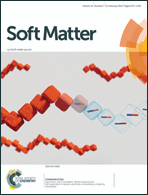 |
A new cover is scored by Laura Rossi et al in Soft Matter. It is a very beautiful combination of the hard synthesis and microscopy work of Laura, synchrotron diffraction data of Janne-Mieke Meijer et al, and computer simulations of Joe Donaldson et al. Please have a look at the paper (open access, free to read!). (February 2018) |
 |
The European Synchrotron ESRF has selected our publication for ESRF Highlights 2017. The highlighted paper is by Shenyu Yang et al., published in Nature Communications, 2017. Please have a look at the whole book of ESRF Highlights (177 pages) or jump to our story (page 68-69). (February 2018) |
| Shenyu Yang et al., Nature Comm, 2017. |
|
 |
In January 2018 I was appointed as Editor-in-Chief of the Section Advanced Nanomaterials in MDPI journal Materials. Please visit the home page of the Section and of its Editorial Board. Please consider submitting your manuscript to our Section in this open-access journal! According to Web of Science data, the impact factor is 2.654 (2016) and 5-year impact factor is 3.236 (2016). |
 |
On October 2, 2017 Jaco Geuchies (middle) has successfully defended his PhD thesis. On this photo taken after the defense, he is surrounded by his two co-promotors, myself (left) and dr. Oleg Konovalov from ESRF (right). Jaco holds a gift with the cover page of an issue of Nature Materials based on his paper. The promotor of Jaco was Daniel Vanmaekelbergh. Click on the photo to enlarge. |
 |
I was elected as chairman of the International Advisory Council of the Immanuel Kant Baltic Federal University (IKBFU) in Kaliningrad, Russia. I am working in IAC since 2016. My colleagues are not only exact scientists but also a philosopher, a cultural historian, a professor of medicine, etc. It is an interesting experience to look at the topics on the university level. (September 2017) |
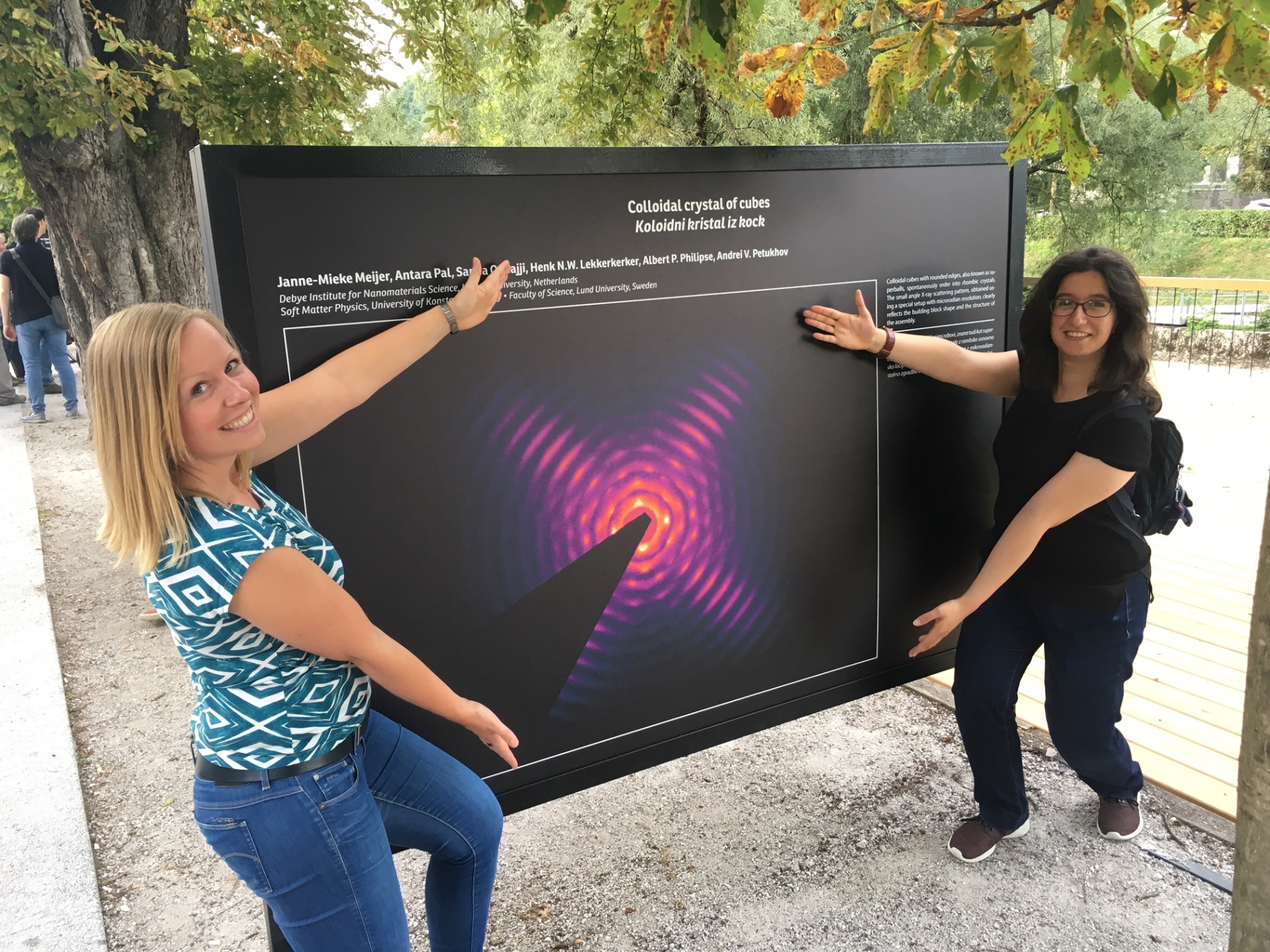 |
Artwork of Janne-Mieke Meijer et al. was selected for public outdoor display during the Liquids 2017 conference in Ljubljana in July 2017. The photo on the left shows Janne-Mieke with her co-author Samia Ouhajji in front of the poster in Ljubljana. This and other selected artworks can be seen on this conference website. |
 |
Interview published in Chemograph, the periodical of chemistry student association Proton. To open the PDF file, use password Proton. See pages 32-34. (May 2017) |
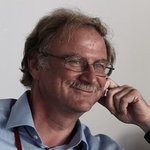 |
Interview by DUB (Independent digital portal of Utrecht University) about the role of English and Dutch languages at the university (in Dutch) Schei- en natuurkundige Andrei Petoukhov komt vanachter het IJzeren Gordijn: 'Ik heb het Nederlands van Philip Freriks geleerd'... (March 2017) |
 |
Observing new ways to stack colloidal cubes The self-organisation of colloidal cubes leads to the creation of novel ordered structures with fascinating optical properties... (February 2017) |
 |
‘Superballs’ organise themselves into interesting structures (in English) ‘Superbollen’ organiseren zichzelf in interessante structuren (in Dutch) Colloids – particles with a diameter of only one thousandth of a millimetre – can spontaneously organise into ordered structures with fascinating optical properties... (February 2017) |
| Meijer et al., Nature Comm, 2017. |
|
 |
News of Immanuel Kant Baltic Federal University (IKBFU), Kaliningrad (Sept 2016): First meeting of the International Advisory Council (IAC IKBFU) Public lectures of members of IAC IKBFU (in Russian) see also LNMM news (in English) |
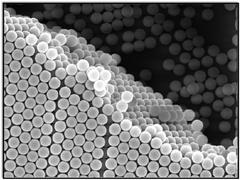 |
Photonic crystals in 3D (in English) Photonische Kristalle in 3D (in German) Innovative technique allows to analyse mesoscopic materials directly (Sept 2016) See also DESY Highlights 2016 (page 48-49). |
| Shabalin, Meijer, et al., PRL, 2016. PRL Editors' Suggestion. |
|
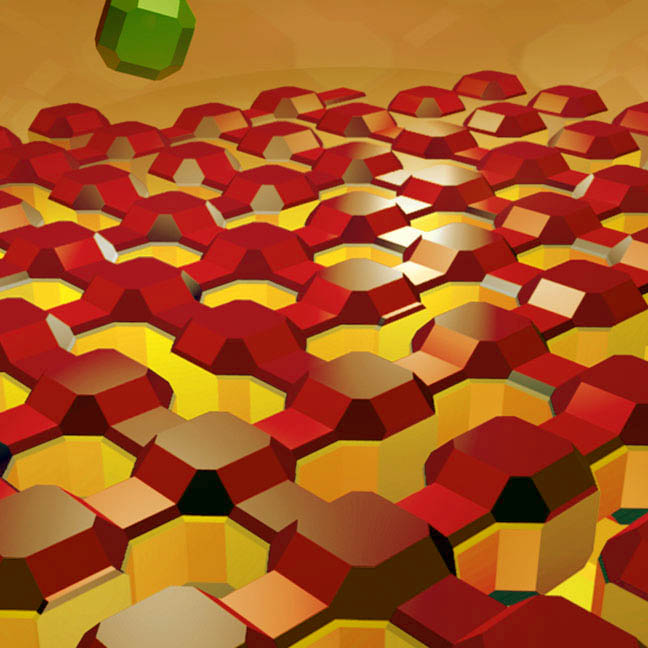 |
Watching the birth of a nanocrystal superlattice Two-dimensional systems have recently emerged as very promising candidates for future electronic devices. An ordered 2D array of nanocrystals can be created by... (Sept 5, 2016) See also ESRF Highlights 2016 (page 103-104). |
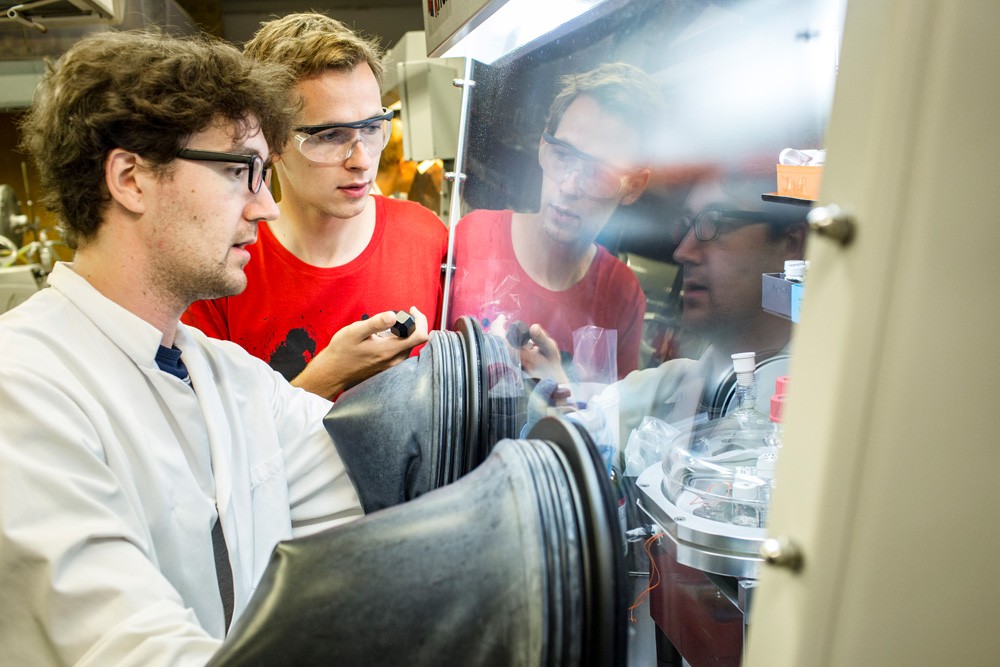 |
‘Incomprehensible’ birth of supercrystal explained (in English) ‘Onbegrijpelijke’ geboorte superkristal begrepen (in Dutch) Important step in research into new materials (Sept 2016) |
| Geuchies, van Overbeek et al., Nature Materials, 2016. COVER |
|
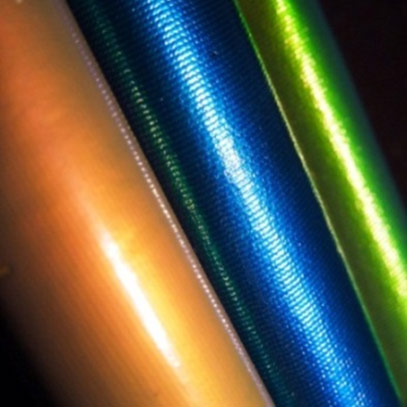 |
Iridescent flexible films see the light of day Stacking microscopic marbles into regular layers produces intriguing materials that scatter light in such a way that they produce intense colours. A team led by the University of Cambridge and including scientists from Germany, the Netherlands and Japan, has invented a way to make sheets of such a material on an industrial scale... (June 2016) |
 |
Squeezing out opal-like colours by the mile (in English) Opaalachtige kleuren maken op industriële schaal (in Dutch) Researchers have devised a new method for stacking microscopic marbles into regular layers, producing intriguing materials which scatter light into intense colours, and which change colour when twisted or stretched... (June 2016) |
| Zhao et al., Nature Comm, 2016. For more news articles and other altmetric data, see this page at nature.com. |
|
 |
Yet another journal cover Cinematography of melting colloidal crystals is selected for the front cover of Langmuir (June 2015) Also highlighted at the front page of DESY, http://photon-science.desy.de in June & July 2015. |
| Sulyanova et al., Langmuir, 2015. |
|
 |
Colloidal crystals with novel symmetry are induced by magnetic interactions Spontaneous formation of colloidal crystals with body-centered tetragonal structure is demonstrated in our DUBBLE experiment (March 2015) |
| Pal et al., Angew. Chemie Int. Ed., 2015. |
|
 |
Self-organization of colloids in microtubules is highlighted on a journal cover Wiley's journal "Particle & Particle Systems Characterization" has selected our recent results for its front inside cover (March 2015) |
| de Folter, Liu et al., Particle & Part. Syst. Char., 2015; cover. |
|
 |
Artificial graphene made of semiconductor quantum dots Quantum dot superlattices are structures that can be formed through the self-assembly of colloidal semiconductor nanocrystals, which are nanoparticles with size-dependent properties [1]. Many applications... (ESRF Highlights 2014, p.104-105) |
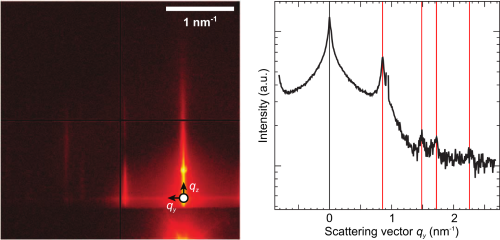 |
Honeycomb ‘artificial graphene’ nanocrystal structure studied at the ESRF An international team of researchers has studied a new material at the European Synchrotron, the ESRF, which sees nanocrystals, or artificial atoms, arranging themselves in an orderly way to form a honeycomb structure... (June 2014) |
 |
Honeycomb structure of nanocrystals offers the best of both worlds A research team led by professor Daniel Vanmaekelbergh (Chemistry) has discovered how a new material with attractive electronic properties is formed... (May 2014) |
| Boneschanscher et al., Science, 2014. There were more highlights including "het Financieële Dagblad" & "C2W". |
|
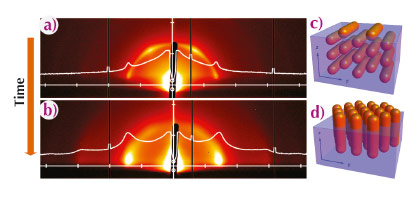 |
The dynamics of nanorod self-assembly at the liquid/air interface studied with GISAXS The ability to manipulate the chemical and physical properties of colloidal nanocrystals at the atomic level, together with the ability to assemble them into ordered 2D membranes and 3D solids is currently one of the most fascinating and challenging directions of nanoscience [1]. In particular, ... (ESRF Highlights 2013) |
| Pietra et al., Nano Lett., 2013. |
|
 |
Helix forms inside self-assembled cylinder Chemists discover ‘double self-organisation’ (March 2013) |
| Jiang, de Folter et al. Angew. Chem., 2013. Also highlighted in the national newspaper "de Volkskrant" and "C2W". |
|
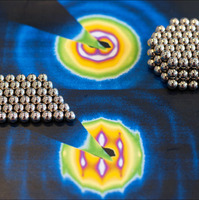 |
Adding new dimensions to the self-assembly of nanomagnets Dipolar interactions between colloidal particles generate unusual self-organised architectures that could pave the way to novel applications. Magnetic core-shell nanoparticles in suspension were recently studied at the ESRF... (October 2012) |
| Malik et al., Langmuir, 2012. | |
 |
Martha "cow-laborates" to help unravel protein structure in milk Martha, a cow placidly grazing in a field in The Netherlands, became an important collaborator with researchers who successfully analyzed and characterized the internal protein structure and the composite particles of her milk using small-angle neutron scattering at ORNL’s High Flux Isotope Reactor (HFIR)... (March 2012) |
| De Kruif et al., Adv. Coll. Interf. Sci., 2012. | |
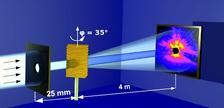 |
Imaging defects with coherent X-rays Visualize the core (DESY Photon Science Report 2010) |
| Gulden et al., PRB, 2010. | |
 |
Biaxial liquid crystals found in colloidal dispersions Biaxial liquid crystals in goethite dispersions were discovered using small-angle X-ray scattering. Uniaxial liquid crystals, with only one optical axis, are widely used in liquid crystal displays (LCDs). Biaxial liquid crystals, with full 3D optical anisotropy, can make displays and optical switches much faster and might open doors to new technologies... (March 2010) |
 |
'Cinderella' - biaxial liquid crystal - is found at last Recent research at the DUBBLE beamline has proved the existence of liquid crystals with two main axes. Liquid crystals with a single main axis are already used in LCDs (liquid crystal displays), but crystals with two main axes can make computer monitors and optical switches much faster, as well as opening doors to new technologies... (February 2010) |
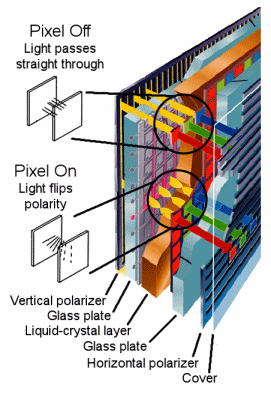 |
Wetenschappers ontdekken nieuw Liquid Crystal Een Biaxaal vloeibaar kristal met een DUBBLE-bundellijn is ontdekt. Onderzoekers van de Universiteit van Utrecht ontdekten per toeval het langverwachte molecuul. DUBBLE-bundellijn houdt in dat er twee hoofdassen aanwezig zijn. De variant met één enkele hoofdas is al jaren te vinden in LCD-schermen. De nieuwe kristallen kunnen de technologie een grote stap vooruit brengen... (Funny interpretation of our results by a journalist; January 2010) |
 |
Nieuw type vloeibaar kristal mogelijk inzetbaar voor 3d-lcd Utrechtse onderzoekers hebben een speciaal soort vloeibaar kristal ontdekt dat twee hoofdassen heeft. Deze liquid crystals met dubbele assen zouden op termijn gebruikt kunnen worden in beeldschermen voor 3d-televisie... (Link to 3D television is an addition of the journalist; January 2010) |
| Van den Pol et al., PRL, 2009. There were more highlights including press releases of NWO (not on-line anymore). | |
 |
Stacking faults in colloidal photonic crystals revealed by microradian X-ray diffraction The presence of a network of intersecting stacking faults in self-assembled colloidal crystals was demonstrated with X-ray diffraction with microradian resolution. These defects can seriously affect the optical properties of photonic materials fabricated using colloid self-assembly... (Nov 2009) |
| Hilhorst et al., Langmuir, 2009. | |
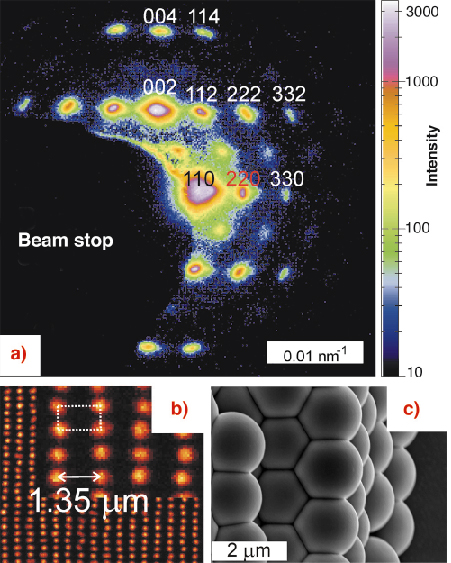 |
Microradian X-ray Diffraction in Colloidal Photonic Crystals and Liquid Crystals Self-assembly of colloidal particles into various crystalline and liquid-crystalline structures have been widely studied as a model of crystallisation of atomic and molecular systems as well as a route to photonic materials. The application of X-ray diffraction (XRD) to colloidal crystals is challenging due to many orders of magnitude difference between the size of a colloid and an X-ray wavelength. Angular resolutions of the order of a microradian are required to measure the intrinsic width of the diffraction peaks. Recent experiments performed at beamlines ID10A TROÏKA and BM26 DUBBLE met the challenge... (ESRF Highlights 2005) |
| Petukhov et al., J. Appl. Crysr, 2006 & Petukhov et al., PRL, 2006. | |
 |
Colloidal Discs Trade their Order Every child playing with blocks knows how difficult it is to build a wall or a tower using blocks that are slightly different. A similar problem is known in self-organisation of colloids. For example, colloidal hard spheres usually fail to crystallise if their size polydispersity sigma approaches ~ 10%. Surprisingly, ... (Sept 2005) |
| Petukhov et al., PRL, 2006. | |
 |
Kijken naar kromme oppervlakken Combinatie van moderne laserspectroscopie met oude lichttheorie maakt het mogelijk tot in detail gekromde oppervlakken van deeltjes in oplossingen te onderzoeken zoals celmembranen, liposomen en nanodeeltjes... (January 2004) |
 |
Verborgen oppervlakken belicht Wetenschappers van de Universiteit Leiden, de Universiteit Utrecht en de Stichting FOM zijn erin geslaagd oppervlakken die normaal nauwelijks te bestuderen zijn, toch te analyseren en karakteriseren. Door een moderne techniek... (January 2004) |
| Roke et al., PRL, 2003, also highlighted in the monthly magazine "Natuurwetenschap & Techniek". | |
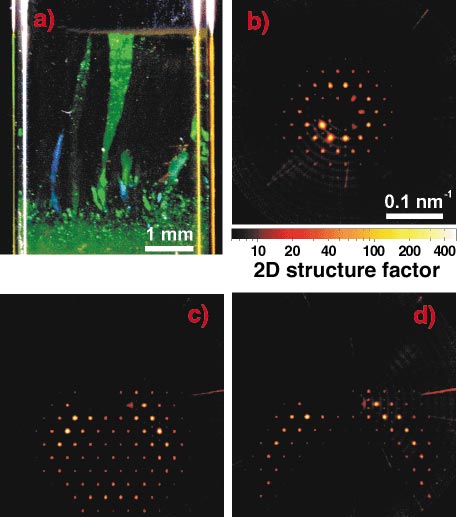 |
Glass Microspheres Generate Perfect Aperiodic Order Self-organisation of colloidal hard spheres into crystalline structures provides an important model of atomic crystal growth and attracts significant attention as a technique for inexpensive, large-scale fabrication of photonic materials. A crystal is said to be perfect when the positions of the "atoms" (in the present case the micro-spheres) are correlated throughout the whole crystal despite their thermal motion. In reality, however... (ESRF Highlights 2002) |
| Petukhov et al., PRL, 2002 & Petukhov et al., PRL, 2003. | |
Chirality is abundant in nature and plays an important role in biology, chemistry and physics. Symmetry breaking and handedness establishment lead to essentially novel phenomena such as coupling of the translational degrees of freedom and self-propelling.
Within the proposed research, we shall develop novel synthesis methods to fabricate colloids with chiral shape resembling that of DNA. To this end we shall use the molecular/colloidal co-assembly method recently discovered by us. In this approach molecular self-assembly of surfactant (SDS) and cyclodextrin (β-CD) complexes yields hollow tubes of a well-defined size, which confine colloidal particles in their interior. The chiral assemblies are then formed due to simple geometrical restrictions. The co-assembly approach will be further optimised to increase the yield of chiral assemblies and to gain better control of their geometrical parameters. This will be achieved by varying details of the SDS@2β-CD system as well as by testing other molecular tube-forming systems. The crucial step of this proposal is to develop synthesis methods to fix the generated dynamic colloidal assemblies in order to fabricate chiral colloidal particles, which will be stable after the cylindrical confinement is removed.
The synthesised particles will then be used to study the effects of chirality on their anisotropic Brownian and induced motion, self-propelling, etc. We shall subsequently develop separation techniques to yield monodisperse fractions with well-defined handedness. We shall study the interactions of chiral colloids with liquid-crystalline chiral media such as the cholesteric phase, which can provide new means to influence the latter with possible novel applications in the display technology and photonics. Furthermore, we shall investigate the effects of the particle chirality on their pair-wise interactions such as excluded volume, hydrodynamic and screened electrostatic, which can play a role for biological macromolecules. Finally, studies of the self-assembly of chiral colloids will be initiated.
There is a need for chiral structures on colloidal length scales, for example, to control the optical properties of materials. Although examples exist in nature of materials that self-assemble into chiral structures, the mechanisms for the transfer of chirality on a molecular length scale to the colloidal length scale are often unclear. The objective of this proposal is to study chiral self-assembly on a colloidal length scale in confinement. We will focus on the self-assembly of cellulose, known to show a chiral nematic phase, in the presence of temperature reversible supramolecular microtubules of sodium dodecyl sulphate (SDS) and β-cyclodextrin (β-CD). The microtubules are a versatile model for confining pores, while allowing in-situ measurement of the structure and dynamics of the co-assembly. Moreover, we can modify the microtubules using conventional wet-chemical methods...
This project was developed by Jasper Landman, the winner of the Debye graduate programme, who is now working on it as a PhD student. Part of the project is co-funded by the ESRF.
The objective of the proposed research is to develop colloidal particles with adjustable valence, and study their aggregation properties. Here, ‘valence’ is defined broadly as a measure for the potential number of bonds formed with other colloids, and corresponds to the number of sticky patches on the surface of a colloidal particle. We have recently developed a method to produce colloidal particles with adjustable number of patches and angles between them, see [Kraft et al., JACS 131, 1182, (2009); Soft Matter DOI: 10.1039/b910593j (2009)]. We propose to exploit and explore this unique system by making the patches sticky...
I was co-applicant of this project (PI: Willem Kegel). I supervised Antara Pal and acted as an advisor in the PhD project of Joost Wolters.



